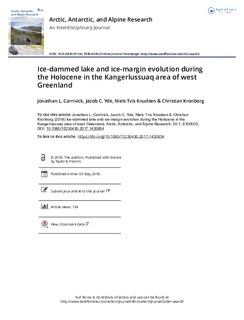| dc.contributor.author | Carrivick, Jonathan L. | |
| dc.contributor.author | Yde, Jacob Clement | |
| dc.contributor.author | Knudsen, N.T. | |
| dc.contributor.author | Kronborg, Christian | |
| dc.coverage.spatial | Greenland | nb_NO |
| dc.date.accessioned | 2019-02-19T09:44:24Z | |
| dc.date.available | 2019-02-19T09:44:24Z | |
| dc.date.created | 2018-09-26T10:12:08Z | |
| dc.date.issued | 2018 | |
| dc.identifier.citation | Carrivick, J. L., Yde, J. C., Knudsen, N. T., & Kronborg, C. (2018). Ice-dammed lake and ice-margin evolution during the Holocene in the Kangerlussuaq area of west Greenland. Arctic, Antarctic, and Alpine Research, 50(1). | nb_NO |
| dc.identifier.issn | 1523-0430 | |
| dc.identifier.uri | http://hdl.handle.net/11250/2586154 | |
| dc.description.abstract | There is a lack of detailed information on the Holocene evolution of the west Greenland ice margin, not least because it was farther inland than at present and thus at present is covered by ice. Suggestions have been put forward, both of relatively quick ice-margin retreat and of relatively stable ice-margin positions. This study presents the first exploitation of sediments from an ice-dammed basin. Sediment that is rich in organic material records a period of time sufficient for vegetation to thrive; thus, without a lake and with a distal and diminished ice mass relative to the present. In contrast, sediment composed of suspension-settling deposits and with drop stones records an ice-dammed lake and a proximal calving ice-margin. Overall, we evidence relatively coarse-grained glacifluvial sedimentation predominantly from an ice-marginal delta and/or a proglacial, braided river soon after the early Holocene deglaciation of this area. Subsequent mid-Holocene aeolian activity deposited leaves, some vegetation (roots) developed in the basin, and ponding of water formed organic-rich “gyttja” sediments and thin layers of peat. The lake then became ice marginal, and ice advances are interpreted to have occurred at approximately 4000 cal. yr BP, and between 2776 ± 26 cal. yr BP and 2440 ± 45 cal. yr BP. The Little Ice Age ice-margin advance at Russell Glacier apparently reached its maximum extent after 147 ± 39 cal. yr BP, whereas at Isunnguata Sermia the maximum could have been as early as 245 ± 26 cal. yr BP. Given that ice-marginal lakes are becoming globally ubiquitous, improved resolution and new geological data on lake and ice-margin dynamics and interactions, such as ice-dammed lake-basin sediments, will be important for numerical models for assessing past and future ice-mass evolution. | nb_NO |
| dc.language.iso | eng | nb_NO |
| dc.publisher | Taylor & Francis | nb_NO |
| dc.rights | Navngivelse 4.0 Internasjonal | * |
| dc.rights.uri | http://creativecommons.org/licenses/by/4.0/deed.no | * |
| dc.title | Ice-dammed lake and ice margin evolution during the Holocene in the Kangerlussuaq area of west Greenland | nb_NO |
| dc.type | Journal article | nb_NO |
| dc.type | Peer reviewed | nb_NO |
| dc.description.version | publishedVersion | nb_NO |
| dc.rights.holder | © 2018. The authors. | nb_NO |
| dc.subject.nsi | VDP::Matematikk og Naturvitenskap: 400::Geofag: 450::Kvartærgeologi, glasiologi: 465 | nb_NO |
| dc.source.pagenumber | 11 | nb_NO |
| dc.source.volume | 50 | nb_NO |
| dc.source.journal | Arctic, Antarctic and Alpine research | nb_NO |
| dc.source.issue | 1 | nb_NO |
| dc.identifier.doi | 10.1080/15230430.2017.1420854 | |
| dc.identifier.cristin | 1613674 | |
| cristin.unitcode | 203,5,4,0 | |
| cristin.unitname | Avdeling for ingeniør- og naturfag - Sogn og Fjordane | |
| cristin.ispublished | true | |
| cristin.fulltext | original | |
| cristin.qualitycode | 1 | |

